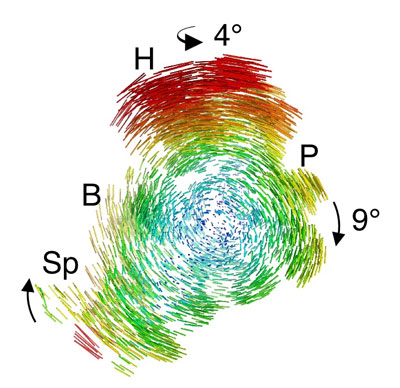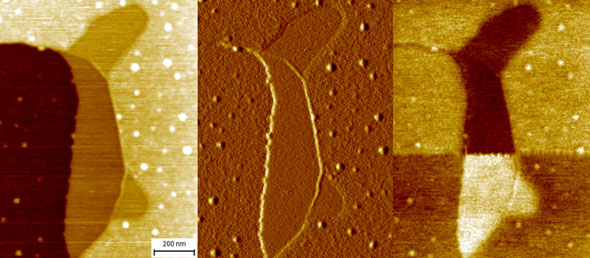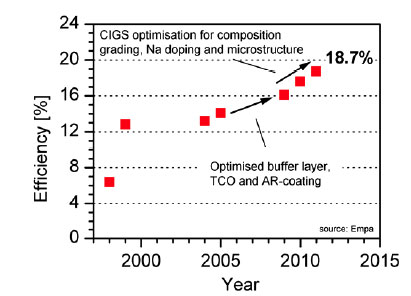Chemical engineers at the Massachusetts Institute of Technology have designed a new type of drug-delivery nanoparticle that exploits a trait shared by almost all tumors: They are more acidic than healthy tissues. Such particles could target nearly any type of tumor, and can be designed to carry virtually any type of drug.
May 20th, 2011
Read more
A class of engineered nanoparticles - gold-centered spheres smaller than viruses - has been shown safe when administered by two alternative routes in a mouse study led by investigators at the Stanford University Medical School. This marks the first step up the ladder of toxicology studies that, within a year and a half, could yield to human trials of the tiny agents for detection of colorectal and possibly other cancers.
May 20th, 2011
Read more
Nanotechnology researchers have known for years that RNA, the cousin of DNA, is a promising tool for nanotherapy, but the difficulties of producing long-lasting, therapeutic RNA that remains stable and non-toxic while entering targeted cells have posed challenges for their progress. Now, in two papers published in the journal Molecular Therapy, a team of investigators details their method for producing RNA nanoparticles and testing their safety in the delivery of therapeutics to targeted cells.
May 20th, 2011
Read more
Melding nanotechnology and medical research, researchers from Sandia National Laboratories, the University of New Mexico, and the UNM Cancer Research and Treatment Center have produced an effective strategy that uses nanoparticles to treat tumors with a melange of anticancer agents. This strategy relies on using silica nanoparticles honeycombed with cavities that can store large amounts and varieties of drugs loaded inside a lipid-based nanoparticle known as a liposome.
May 20th, 2011
Read more
A team of investigators from Stanford University has developed a new biosensor microchip that could significantly speed up the process of drug development. The microchips, packed with highly sensitive magnetic nanosensors, analyze how proteins bind to one another, a critical step for evaluating the effectiveness and possible side effects of a potential medication.
May 20th, 2011
Read more
CRDF Global is soliciting applications from U.S. researchers in the field of nanotechnology to serve as subject matter experts and presenters at a 3-day workshop entitled "On the Frontiers of Nanotechnology: Research and Collaboration in the U.S. and Uzbekistan" in Tashkent, Uzbekistan on September 21-23, 2011.
May 20th, 2011
Read more
3-dimensional surfaces with features below 100 nanometres have numerous applications ranging from optics to life sciences. The development of new manufacturing processes, based on nanoimprinting techniques (NIL), is a core aspect for the success of these applications.
May 20th, 2011
Read more
Auf der Suche nach Materialien etwa fuer elektronische Bauteile koennen Physiker kuenftig einer neuen Spur folgen: Ein internationales Forscherteam hat zum ersten Mal praezise beobachtet, wie sich die physikalischen Eigenschaften einer Substanz - genauer gesagt des Metalloxids Lanthannickeloxid - aendern, wenn es in zweidimensionaler statt dreidimensionaler Form verarbeitet wird.
May 20th, 2011
Read more
 NVIDIA and the CGSociety, a division of Ballistic Media, have announced 'NVArt 6: Moving Innovation', a new worldwide digital art contest for artists to explore the future of electronic device design, with over $34,000 in prizes.
NVIDIA and the CGSociety, a division of Ballistic Media, have announced 'NVArt 6: Moving Innovation', a new worldwide digital art contest for artists to explore the future of electronic device design, with over $34,000 in prizes.
May 20th, 2011
Read more
Touch control, based on innovative large-area capacitive sensors, is enjoying exponential market growth. LOPE-C 2011 in Frankfurt, Germany, will present the state of the art and the trends of touch.
May 20th, 2011
Read more
In the computer displays of medical equipment in hospitals and clinics, liquid crystal technologies have already found a major role. But a discovery reported from the University of Wisconsin-Madison suggests that micrometer-sized droplets of liquid crystal, which have been found to change their ordering and optical appearance in response to the presence of very low concentrations of a particular bacterial lipid, might find new uses in a range of biological contexts.
May 19th, 2011
Read more
 Berkeley Lab scientists reveal how protein-making machine bends without breaking.
Berkeley Lab scientists reveal how protein-making machine bends without breaking.
May 19th, 2011
Read more
Research proposals from University of Bath and Manchester's Metropolitan University confirmed as winners.
May 19th, 2011
Read more
 Scientists from NPL, in collaboration with Linkoping University, Sweden, have shown that regions of graphene of different thickness can be easily identified in ambient conditions using Electrostatic Force Microscopy (EFM).
Scientists from NPL, in collaboration with Linkoping University, Sweden, have shown that regions of graphene of different thickness can be easily identified in ambient conditions using Electrostatic Force Microscopy (EFM).
May 19th, 2011
Read more
 Scientists at Empa, the Swiss Federal Laboratories for Materials Science and Technology, have further boosted the energy conversion efficiency of flexible solar cells made of copper indium gallium (di)selenide (also known as CIGS) to a new world record of 18.7% - a significant improvement over the previous record of 17.6% achieved by the same team in June 2010.
Scientists at Empa, the Swiss Federal Laboratories for Materials Science and Technology, have further boosted the energy conversion efficiency of flexible solar cells made of copper indium gallium (di)selenide (also known as CIGS) to a new world record of 18.7% - a significant improvement over the previous record of 17.6% achieved by the same team in June 2010.
May 19th, 2011
Read more
Scientists at the California Institute of Technology (Caltech) have conducted experiments confirming which of three possible mechanisms is responsible for the spontaneous formation of three-dimensional pillar arrays in nanofilms. These protrusions appear suddenly when the surface of a molten nanofilm is exposed to an extreme temperature gradient and self-organize into hexagonal, lamellar, square, or spiral patterns.
May 19th, 2011
Read more





 Subscribe to our Nanotechnology News feed
Subscribe to our Nanotechnology News feed